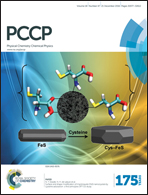Scaling relationships for nonadiabatic energy relaxation times in warm dense matter: toward understanding the equation of state
Abstract
Understanding the dynamics of electron–ion energy transfer in warm dense (WD) matter is important to the measurement of equation of state (EOS) properties and for understanding the energy balance in dynamic simulations. In this work, we present a comprehensive investigation of nonadiabatic electron relaxation and thermal excitation dynamics in aluminum under high pressure and temperature. Using quantum–classical trajectory surface hopping approaches, we examine the role of nonadiabatic couplings and electronic decoherence in electron-nuclear energy transfer in WD aluminum. The computed timescales range from 400 fs to 4.0 ps and are consistent with existing experimental studies. We have derived general scaling relationships between macroscopic parameters of WD systems such as temperature or mass density and the timescales of energy redistribution between quantum and classical degrees of freedom. The scaling laws are supported by computational results. We show that electronic decoherence plays essential role and can change the functional dependencies qualitatively. The established scaling relationships can be of use in modelling of WD matter.



 Please wait while we load your content...
Please wait while we load your content...